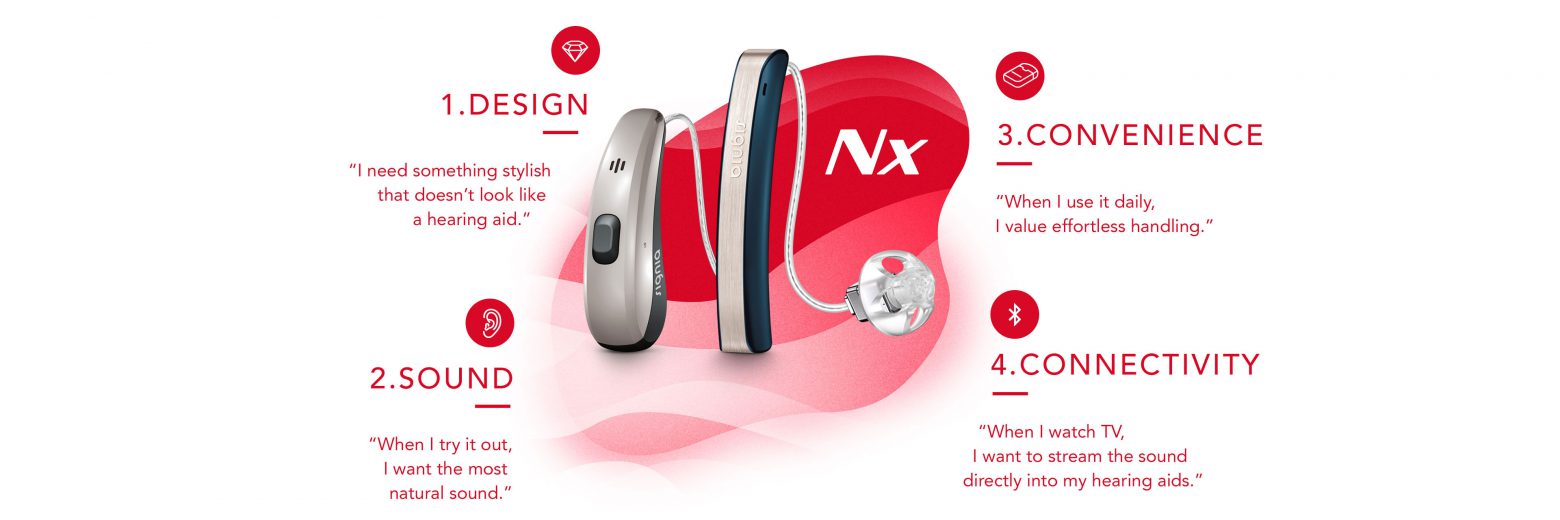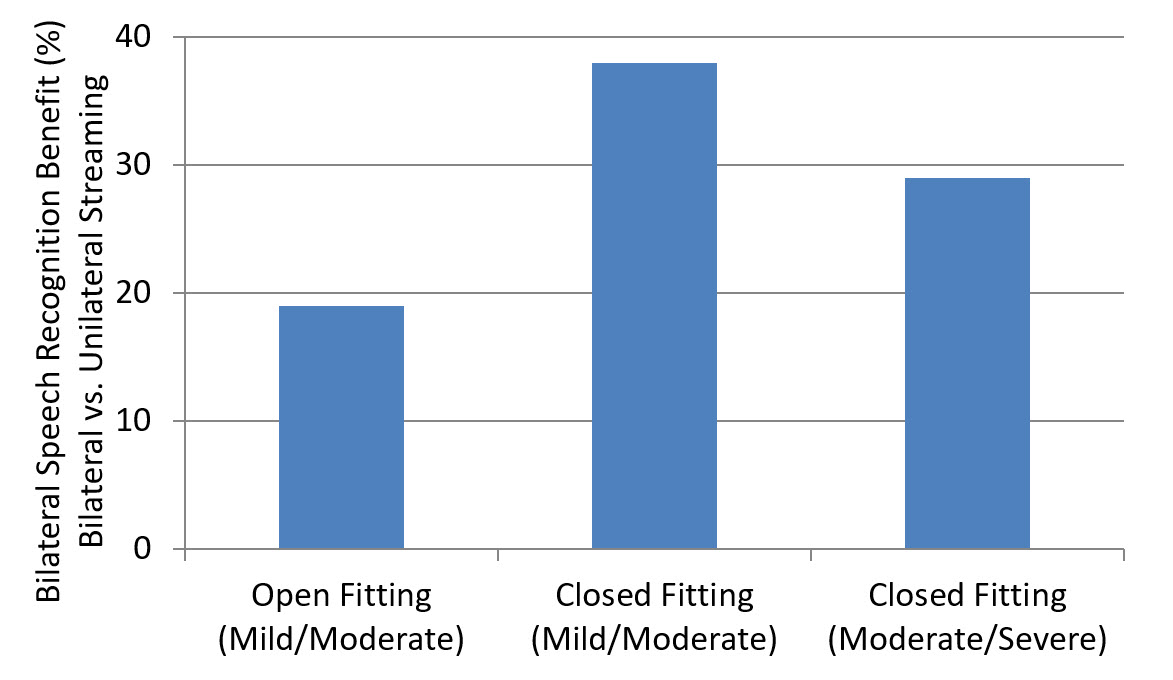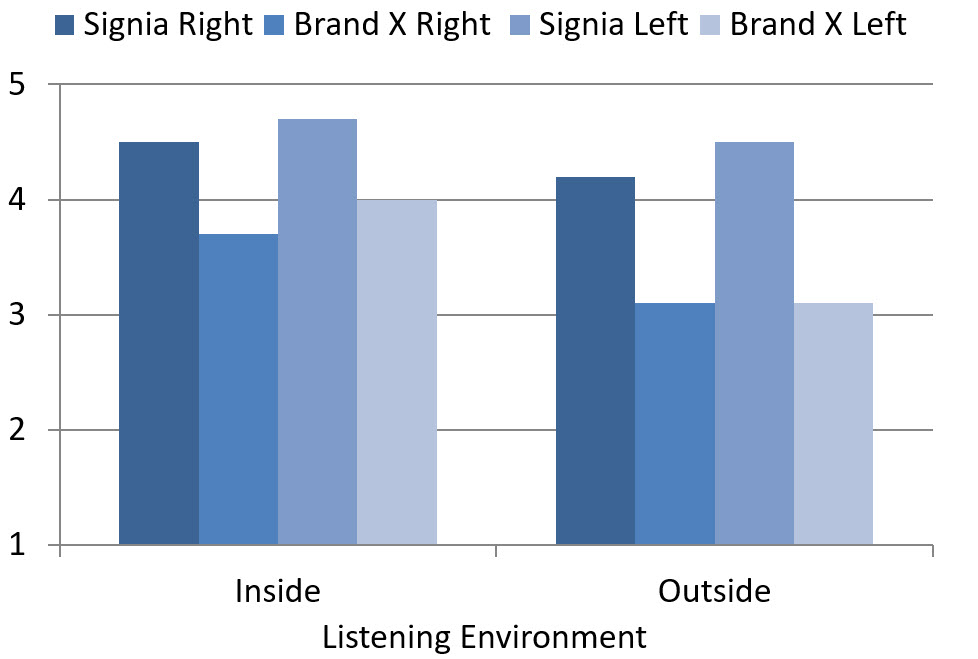Comparison of streamed audio signal quality: what matters in the real world
Matthias Fröhlich

It is well established that human binaural auditory processing is superior to monaural, thanks to the contributions of the brainstem and central auditory system. Advantages include sound localization and situational awareness, sound quality, loudness summation, and enhancement of speech understanding in background noise. Considerable research has supported the notion that, with hearing impaired individuals, these same binaural advantages tend to be present when a bilateral hearing aid fitting is compared to a unilateral one (for review, see Mueller et al, 2014).
To take advantage of this binaural effect, since 2014 Signia has employed full-audio sharing of signals for bilateral hearing aid fittings. In addition to the conventional bilateral advantages, this technology also allows for advanced signal processing such as enhanced wind noise reduction, and directional features including narrow directionality, which significantly improves speech understanding in background noise (e.g., Powers and Froehlich, 2014, Froehlich et al, 2015).
For the past decade, it has become more and more common for hearing aid users to stream phone calls, music and other signals to their hearing aids. Since the early days of this technology, Signia has been a proponent of the bilateral delivery of streamed signals. Regarding quality and understanding in background noise, logic suggests that the bilateral benefits related to redundancy (hearing the same signal twice) and binaural squelch (a central auditory SNR advantage) would be present with bilateral streaming to a similar degree as previously shown in research with traditional bilateral hearing aid processing.
This has proven to be true. Research with Signia hearing aids was conducted at Vanderbilt University, which compared unilateral streaming to bilateral streaming for a group of hearing-impaired with mild-to-moderate losses (Picou and Ricketts, 2011). The results, shown in Figure 1, revealed that with an open fitting, the bilateral advantage for speech understanding in background noise was 20%. This advantage increased to nearly 40% with a closed fitting. A follow-up Signia streaming study also was conducted at Vanderbilt University, determining if a similar advantage was present for individuals with moderate-severe losses (see Figure 1). Again, a significant bilateral vs unilateral streaming advantage of ~30% in speech recognition was observed (Picou and Ricketts, 2013). Related to sound quality, in recent years, research has shown a significant advantage for Signia streamed signals compared to competitive products, with a particular benefit for streamed music (Froehlich et al, 2018).

While research clearly supports the use of bilateral processing, until recently, Signia was the only major hearing aid company to offer both the full exchange and processing of bilateral audio signals along with bilateral direct streaming. Today, there is a second manufacturer who also employs both of these processing features, which we will refer to as Brand X.
Different methods, however, can be used for the bilateral sharing of audio signals. Since 2004, Signia (Siemens) has used Near Field Magnetic Induction (NFMI); in its current form referred to as e2e 3.0 (see review by Herbig et al, 2014). The e2e 3.0 system is capable of transmitting dual-microphone bidirectional audio data from ear to ear, creating a virtual 8 microphone network, using a frequency band at 3 MHz, which is not attenuated by human tissue. Ease of propagation makes it suitable for ear-to-ear sharing of audio signals between two hearing aids, providing the corresponding benefits in the real world that are based on the joint processing of the audio signals from both hearing aids. Furthermore, NFMI has the advantage that it is robust against environmental factors (reflections, interference from other sources). The e2e 3.0 achieves this without size or battery drain drawbacks due to the use of a dedicated design for hearing instruments.
An alternative method to accomplish true bilateral audio sharing between hearing instruments is to use Bluetooth 2.4 GHz, which is what is used by the competitive manufacturer (i.e., Brand X). While a higher battery drain can be balanced by battery capacity (at the cost of battery size), there exist technical challenges with this approach because of the higher absorption of 2.4GHz by the water/tissue of the head and body. Moreover, an advantage of NFMI is the significantly lower power consumption, which allows the wireless link to be active all the time. This means that the binaural signal processing based on the audio sharing can be applied much faster if required by the particular listening situation, and for more features, such as bilateral wind noise reduction.
Given that there are only two major manufacturers who have hearing aid products with both bilateral full-audio data sharing, and direct bilateral streaming available, we designed a comparative research project to evaluate the effectiveness of the streaming of these instruments. The purpose was to not only evaluate the quality of the streamed signals, but to assess the usability for a variety of probable real-world use cases involving the location of the smart phone and the listening environment.
The participants in this study all had normal hearing and were experienced in sound quality judgments. The premier RIC (Receiver In the Canal) hearing aids of Signia (Pure Nx) and Brand X were fitted bilaterally, and programmed according to the default proprietary fitting formula of each manufacturer for a flat 40-dB hearing loss. The hearing aids were then paired to the Apple iPhone (Model 6s, iOS 9.3.3). The signal streamed to all participants was popular music, via the standard Apple music player. The quality and stability of the signal was rated for several different listening conditions:
In total, the participants made 48 different judgments of the quality/stability of the streamed signals for each product (2 ear locations [right and left] x 4 phone locations x 3 head positions x 2 listening environments). For each sound sample, the participants rated the quality and stability of the signal on a five-point scale ranging from “5=High quality with no artifacts” to 1=”No streamed signal audible.”
The study was designed to represent different well-defined difficult environments that represent real-world uses of streaming from a smartphone to the patient’s hearing aids. We know that each hearing aid user has their own “favorite” place to carry their phone, which might be left, right, front or back. We also know that while streaming is occurring, the person is not always facing straight ahead, but may have their head turned to the right or the left. And finally, streaming may occur inside a quiet room (which is often the case during a demonstration for the patient), or use the streaming outside.
The data summarizing the ratings for Signia and Brand X are displayed in the following Figures: Figure 2a and 2b are for the rating from inside the clinic room for the right and left ear respectively; Figures 3a and 3b are the ratings obtained when the participants were outside, for the right and left ears respectively. As can be seen, head position, phone position, and listening environment all impact the ratings, especially for Brand X, and there is an interaction with the ratings for the right and left ears.


Most notable on these Figures is the interaction between phone and head location. This was much more pronounced with the Brand X product, with several ratings below #3. If we simply take the averages for all head positions and phone locations, we see a significant advantage for the Signia product (see Figure 4). For streaming inside in a room, the advantage was 4.5 vs. 3.7 for the right ear, and 4.7 vs. 4.0 for the left ear (based on data from Figure 2 a,b). Interestingly, the average Signia ratings for streaming for the outdoors locations were essentially the same as inside, however, the Brand X ratings dropped significantly, increasing the Signia advantage: 4.2 vs. 3.1 for the right ear and 4.5 vs. 3.1 for the left ear (see Figure 4; based on data from Figure 3 a,b).

If we examine the ratings for outside (Figure 3 a,b), and look for specific situations where there was a large advantage for the Signia product (1 rating unit or more), we see that the largest differences for the right hearing aids were for the following conditions: phone front right/head turned left; phone back left/all head positions. For the left hearing aid, the large differences were for: phone front left/all head positions; phone back left/head center or turned left; back right/all head positions.
If we consider that what would be “acceptable” listening of streaming for the average hearing aid user, that would be a mean rating of 4.0 or better (“Moderate quality, slightly noticeable artifacts”). Using this criterion, for the streaming outside test environment (referring back to Figures 3a, 3b), we see that 20 of the 24 (83%; right and left ear combined) mean ratings meet this criterion for Signia. Only 3 of the 24 conditions (13%) met this criterion for Brand X.
In the past few years, we have seen advances made in hearing aid technology related to the bilateral full-audio sharing of signals. Much has been written about how this technology can allow for the application of narrow directionality, and how this bilateral beamforming can lead to improved speech understanding in background noise. We must also consider, however, how this integrates with the bilateral reception of streamed signals, which for some patients might be more important than the speech-in-noise advantage.
Overall, the findings of this research reveal that the location of the smartphone on the person’s body does matter, particularly with the Brand X product. This is something important for patient counseling (Jons and Meyers, 2019). Moreover, a substantial streaming advantage for the Signia product was present, especially for the outside environment. We should point out that the findings of this research have direct application to the everyday fitting of hearing aids when streaming is an included feature. It is common clinical practice to conduct a demo of the streaming capabilities of the hearing aid in a quiet office, often with the phone itself sitting on a table in front of the patient. As shown in our data, this can be a very poor predictor of how the streaming feature will operate in different real-world listening conditions, and thus fall short of helping the user choose the hearing instrument he or she will be most satisfied with in daily life. Results thus indicate that a Bluetooth based wireless approach as applied by Brand X does not deliver on all basic user needs.
Froehlich M, Freels K, & Powers T (2015, May). Speech recognition benefit obtained from binaural beamforming hearing aids: comparison to omnidirectional and individuals with normal hearing. AudiologyOnline, Article 14338. Retrieved from http://www.audiologyonline.com
Froehlich M, Junius D, Branda E (2018). A Comparison of Signal Quality of Direct Streaming Hearing Aids. Canadian Audiologist, 5 (6).
Herbig R, Barthel R, Branda E (2014). A history of e2e wireless technology. Hearing Review.21(2): 34-37.
Jons C, Meyers C (2019). How to Fit Bluetooth-integrated Hearing Aids to Maximize Patient Satisfaction. Signia Scientific Library, retrieved from http://www.signia-library.com
Mueller HG, Ricketts T, Bentler R (2014). Modern Hearing Aids. San Diego: Plural Publishing.
Picou EM & Ricketts TA (2011). Comparison of wireless and acoustic hearing aid-based telephone listening strategies. Ear and Hearing, 32(2). 209-20.
Picou, EM & Ricketts TA (2013). Efficacy of Hearing-Aid Based Telephone Strategies for Listeners with Moderate-to-Severe Hearing Loss. Journal of the American Academy of Audiology 24. 59-70.
Powers T & Froehlich M (2014). Clinical results with a new wireless binaural directional hearing system. Hearing Review, 21(11), 32-34.

Dr. Matthias Froehlich is global audiology strategy expert for WS Audiology in Erlangen Germany. He is responsible for the definition and validation of the audiological benefit of new hearing instrument platforms. Dr. Froehlich joined WS Audiology (then Siemens Audiology Group) in 2002, holding various positions in R&D, Product Management, and Marketing since then. He received his Ph.D. in Physics from Goettingen University, Germany.